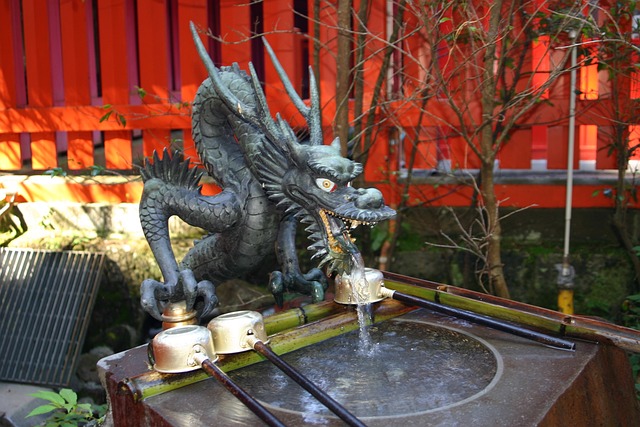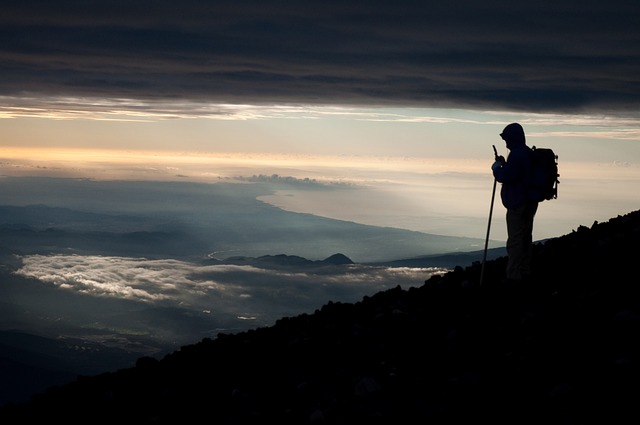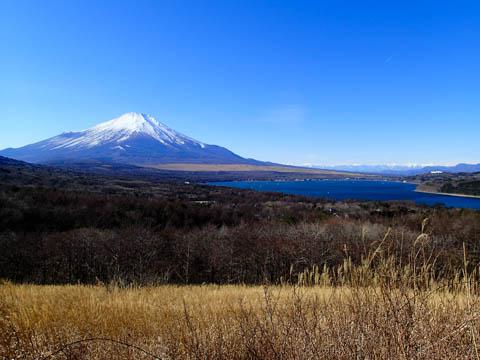It's not a shock that Fuji-Hakone-Izu National Park draws crowds, as it is known for its hiking, museums and attractions, family-friendly activities, and romance.
The best sights of Fuji-Hakone-Izu National Park are its natural features. Mount Fuji, for example is an UNESCO World Heritage Site and has become a renowned symbol for Japan with its stunning snowcapped peak. The ancient eruptions of Mount Fuji are what began the creation of another prime feature of the park-the Fuji Five Lakes. Forming an arch around the norther half of Mount Fuji, the lakes include Lake Kawaguchi, Lake Motosu, Lake Sai, Lake Shoji, and Lake Yamanaka. Also in this general area of the park are the beautiful Shiraito Falls, Aokigahara (also known as the Suicide Forest or Sea of Trees), and Lake Tanuki.
Hakone is another designated hot spot of the park, literally, because of its hot springs. Owakudani, located in Hakone, is a volcanic valley with active sulphur vents and hot springs that have become very popular with tourists. Another attraction of the area is Ashi Lake-known for its views of Mt. Fuji, its numerous hot springs, historical sites, and ryokan. The lake is located on the Tokaido road, the main link between Kyoto and Tokyo. The Hakone Botanical Garden of Wetlands is also popular.
Then we have the Izu Peninsula and its Islands. Some of the main sights of the peninsula include the volcanic Mount Amagi, the Atami Hot Springs, and the Atagawa Tropical & Alligator Garden. As far as the Izu Islands go, the archipelago consists of a chain of volcanic islands, each with a unique character, and many places of scenic beauty.
The array of volcanic mountains makes Fuji-Hakone-Izu National Park a prime location for hiking. There are a number of climbing routes that ascend Mount Fuji as well as the peaks of the Mount Amagi mountain range. Over time, the volcanic activity created the lakes surrounding the mounts, and so any of the park's lakes are now great for fishing, swimming, boating, and other water activities. Some of the most popular include the Fuji Five Lakes and Ashi Lake. Be sure to take a dip in the region's hot springs as well.
As far as the Izu Peninsula goes, it is recognized in the scuba diving community as the most popular destination for mainland Japan diving, with different kinds of opportunities on the east and west coasts. Some scuba companies include Mar Scuba Tokyo, Japan Underwater Explorers, and Scuba Diving Japan.
In addition to soaking up the untouched natural beauty of the Izu Islands, visitors also engage in all sorts of marine sports like swimming, scuba diving, surfing, and fishing.
Museums and Attractions:
 The museums and landmarks in Fuji-Hakone-Izu National Park have earned worldwide fame. Due to its spiritual nature, there have been many shrines built at the base of Mount Fuji. You can visit the Fujisan Hongu Sengen Taisha, which is one of the most significant. Hakone also has many art museums as well as the fascinating Hakone Open-Air Museum.
The museums and landmarks in Fuji-Hakone-Izu National Park have earned worldwide fame. Due to its spiritual nature, there have been many shrines built at the base of Mount Fuji. You can visit the Fujisan Hongu Sengen Taisha, which is one of the most significant. Hakone also has many art museums as well as the fascinating Hakone Open-Air Museum.
Hiking:
 The hiking around Fuji-Hakone-Izu National Park offers breathtaking views. There are hikes within each of the sections of Fuji-Hakone-Izu National Park, but the most famous section is the area around the iconic Mount Fuji. The climbing season is between July and mid September and there are four main trails that lead to the summit. You can take a bus to the Fifth Station and pick up any of the trails at that point. There are also mountain huts where you may take a rest or spend the night.
In the Hakone area, you'll find hot springs and several popular trails such as the Hakone Ropeway and the Mount Kamiyama and Mount Komagatake Trail.
The Izu Peninsula is known for its dramatic coastline, rugged cliffs, and beautiful waterfalls.
Finally, the Izu Islands are a string of islands that can be reached by ferry.
The hiking around Fuji-Hakone-Izu National Park offers breathtaking views. There are hikes within each of the sections of Fuji-Hakone-Izu National Park, but the most famous section is the area around the iconic Mount Fuji. The climbing season is between July and mid September and there are four main trails that lead to the summit. You can take a bus to the Fifth Station and pick up any of the trails at that point. There are also mountain huts where you may take a rest or spend the night.
In the Hakone area, you'll find hot springs and several popular trails such as the Hakone Ropeway and the Mount Kamiyama and Mount Komagatake Trail.
The Izu Peninsula is known for its dramatic coastline, rugged cliffs, and beautiful waterfalls.
Finally, the Izu Islands are a string of islands that can be reached by ferry.
A nice way to explore destinations in Fuji-Hakone-Izu National Park is with local tours that last just a few hours. This way you can see as much as possible in an efficient way with knowledgable guides. Prices vary by the type of activity or tour, the dates, and the size of the group. Here are a few of the highest rated tours by previous visitors:
- Traverse Outer Rim of Hakone Caldera and Enjoy Onsen Hiking Tour for $164 details
- Mount Fuji Scenic E-Bike Tour for $111 details
- Easygoing Nature Walk in Hakone Tour for $41 details
 Fuji-Hakone-Izu National Park, Japan (©MOEJ)
Fuji-Hakone-Izu National Park, Japan (©MOEJ)

 The museums and landmarks in Fuji-Hakone-Izu National Park have earned worldwide fame. Due to its spiritual nature, there have been many shrines built at the base of Mount Fuji. You can visit the Fujisan Hongu Sengen Taisha, which is one of the most significant. Hakone also has many art museums as well as the fascinating Hakone Open-Air Museum.
The museums and landmarks in Fuji-Hakone-Izu National Park have earned worldwide fame. Due to its spiritual nature, there have been many shrines built at the base of Mount Fuji. You can visit the Fujisan Hongu Sengen Taisha, which is one of the most significant. Hakone also has many art museums as well as the fascinating Hakone Open-Air Museum. The hiking around Fuji-Hakone-Izu National Park offers breathtaking views. There are hikes within each of the sections of Fuji-Hakone-Izu National Park, but the most famous section is the area around the iconic Mount Fuji. The climbing season is between July and mid September and there are four main trails that lead to the summit. You can take a bus to the Fifth Station and pick up any of the trails at that point. There are also mountain huts where you may take a rest or spend the night.
In the Hakone area, you'll find hot springs and several popular trails such as the Hakone Ropeway and the Mount Kamiyama and Mount Komagatake Trail.
The Izu Peninsula is known for its dramatic coastline, rugged cliffs, and beautiful waterfalls.
Finally, the Izu Islands are a string of islands that can be reached by ferry.
The hiking around Fuji-Hakone-Izu National Park offers breathtaking views. There are hikes within each of the sections of Fuji-Hakone-Izu National Park, but the most famous section is the area around the iconic Mount Fuji. The climbing season is between July and mid September and there are four main trails that lead to the summit. You can take a bus to the Fifth Station and pick up any of the trails at that point. There are also mountain huts where you may take a rest or spend the night.
In the Hakone area, you'll find hot springs and several popular trails such as the Hakone Ropeway and the Mount Kamiyama and Mount Komagatake Trail.
The Izu Peninsula is known for its dramatic coastline, rugged cliffs, and beautiful waterfalls.
Finally, the Izu Islands are a string of islands that can be reached by ferry. Budget Your Trip is all about finding out how much everything costs so that you can travel cheaper and longer. Created by avid travelers Laurie and Bryan, our goal is to help you plan your next trip on the right budget. With average daily travel costs that are calculated from the budgets of real travelers, plus an analysis of hotel and tour prices, you can find out how much money you need to plan your next adventure. We also have plenty of travel advice, accommodation reviews, and activity suggestions.
Budget Your Trip is all about finding out how much everything costs so that you can travel cheaper and longer. Created by avid travelers Laurie and Bryan, our goal is to help you plan your next trip on the right budget. With average daily travel costs that are calculated from the budgets of real travelers, plus an analysis of hotel and tour prices, you can find out how much money you need to plan your next adventure. We also have plenty of travel advice, accommodation reviews, and activity suggestions.